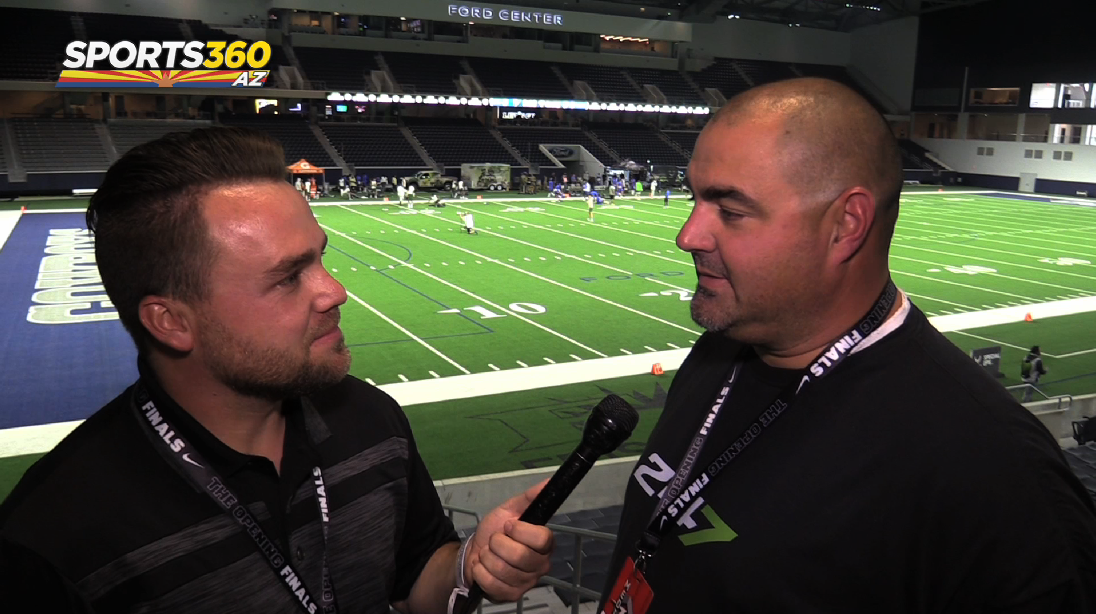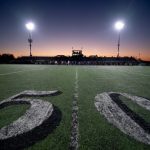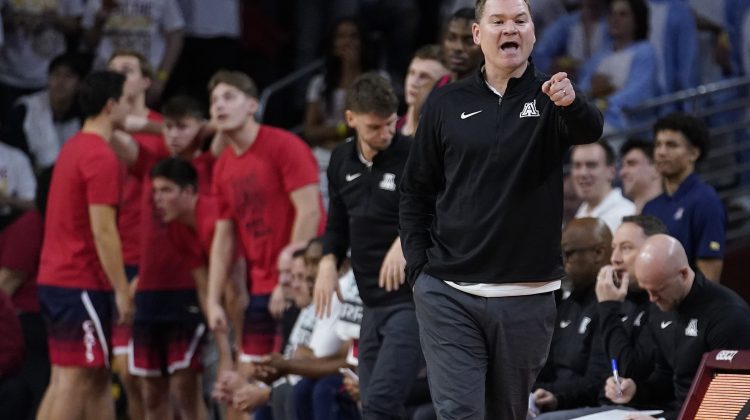Connecticut was not featured in this space last year. We didn’t have Florida Atlantic or Miami in our ridiculously early rankings for the 2022-23 season, either.
San Diego State? Yes, we included the Aztecs, albeit way down the list — in the No. 23 position.
But of the top three teams in our projections last April, one was eliminated in the first round (Kentucky) and two missed the ’23 NCAA Tournament altogether (Michigan and North Carolina). So we have that going for us.
Undaunted — and admittedly desperate to forget the previous installment — the Hotline presents our ridiculously early top 25 for next season, with the following (standard) caveat: The order will be reassessed in early June, following transfer decisions and the NBA Draft deadline.
Here we go …
Also considered: Arizona State, Auburn, Boise State, Indiana, Iowa State, Louisville, Memphis, Mississippi, Missouri, Nevada, Oregon, Penn State, Pitt, Princeton, Providence, St. John’s, TCU, Texas, Virginia, West Virginia
1. UConn: The NBA Draft awaits wing Jordan Hawkins, but what of the Huskies’ other key pieces? Another Final Four run depends on whether Adama Sanogo and Andre Jackson also depart. But coach Dan Hurley has a top-five recruiting class arriving, so the backslide could be limited.
2. Purdue: All signs point to center Zach Edey returning as the game’s most dominant force. (He’s not a high-value NBA prospect.) Advancement deep in the NCAA Tournament hinges on improved play from guards Braden Smith and Fletcher Loyer to lighten Edey’s load.
3. Duke: The Blue Devils undoubtedly will lose a few huge talents to the NBA, but wing Tyrese Proctor isn’t one of them: He already has confirmed his return. Coach Jon Scheyer has another loaded recruiting class for his second year in charge.
4. Marquette: One of the nation’s top surprises in 2022-23 won’t be overlooked next season, not with many of the core rotation players expected to return. In that regard, Marquette is the top-10 team least likely to plunge in the second edition of these rankings (later this spring).
5. Michigan State: The Spartans reached the Sweet 16 and appear well positioned for a first-rate season in 2023-24 with a slew of blue-chip recruits joining what could be a stocked roster. If guard Tyson Walker turns pro, we’ll reconsider this lofty placement.
6. Kansas: For the moment, we’re assuming Bill Self returns to the bench and crafts another exquisite regular season (even without Gradey Dick and Jalen Wilson). If health problems continue to intervene, KU’s trajectory becomes uncertain.
7. Creighton: The Bluejays look loaded for next season. Their top players, including guards Ryan Nembhard, Trey Alexander and Arthur Kaluma, aren’t viewed as elite NBA Draft prospects and therefore seem likely to return. If so, Creighton stands as a Final Four frontrunner.
8. Kentucky: With intense scrutiny on his job performance, coach John Calipari has returned to the one-and-done blueprint for prior success in Lexington: The Wildcats have signed the nation’s No. 1 overall recruiting class and the top prospects at three positions (plus the second-rated point guard in the land).
9. UCLA: There is plenty to sort through in Westwood, where Jaime Jaquez Jr. and Tyger Campbell are expected to move on. If Adem Bona and Amari Bailey pass on the NBA Draft, the Bruins should remain elite. (We like sophomore point guard Dylan Andrews.) If Bona and Bailey depart, the rebuild will be significant.
10. Arkansas: The Hogs will lose Nick Smith and Devo Davis to the NBA but have more than enough talent lined up to justify lofty expectations. Until proven otherwise, we view them as a lock for the Sweet 16 under coach Eric Musselman.
11. San Diego State: We have staked out the middle ground with the Aztecs. An elevated outlook (compared to previous seasons) is fully warranted given the success this spring and expected momentum; but the projected roster doesn’t quite support a top-10 ranking, for now. We suspect SDSU will be a destination for high-level transfers.
12. Houston: Look for the Cougars to regress a tad next season with several key players moving to the NBA and with the school itself moving into the rugged Big 12. The elevated competition will prepare Houston for the NCAAs but also result in a lower seed — and a tougher path through March.
13. Alabama: Brandon Miller is off to the NBA with several teammates perhaps in tow. Draft decisions will shape the outlook in Tuscaloosa, with a wide range of outcomes. In a best-case scenario, point guard Jahvon Quinerly is running the show once again.
14. FAU: From a No. 9 seed to the Final Four to … where? The Owls are set to return eight of their top-nine players — and coach Dusty May is expected to sign a huge contract extension — but must navigate heightened expectations and a new conference, the American.
15. Arizona: These projections are focused on the regular season, and coach Tommy Lloyd’s program has proven adept on that front. We view point guard Kerr Krissa’s departure as addition by subtraction and, for the moment, expect forward Azuolas Tubelis to return. That said, if Lloyd doesn’t forge a tougher roster, another early exit from the NCAA awaits.
16. Miami: The Final Four run reflects a stout foundation that should keep the Canes relevant next season regardless of attrition. (Isaiah Wong’s plans are atop the list of unknowns.) Also working in their favor: regression by traditional ACC powers that has created a void for opportunistic programs.
17. Xavier: The Musketeers far exceeded expectations under first-year coach Sean Miller, whose ability to identify and collect talent will keep the program rolling despite the loss of several key pieces.
18. Baylor: Any program with 104 wins in the past four years while playing in one of the nation’s best leagues warrants a spot in these early rankings. But the departures of Adam Flagler and Keyonte George create a daunting challenge for Scott Drew and Co.
19. USC: One member of the terrific backcourt, Drew Peterson, is out of eligibility; the other, Boogie Ellis, has one year remaining but is nonetheless expected to turn pro. No matter. The Trojans have a slew of athletic wings and signed the nation’s No. 1 prospect (any position) in point guard Isaiah Collier.
20. Texas A&M: The Aggies won 25 games but were bounced from the NCAAs in the first round. They are scheduled to return enough production to maintain their success under Buzz Williams — and once again challenge for the SEC title.
21. Gonzaga: Drew Timme is moving on, and we believe Julian Strawther will do the same. What’s left? Several intriguing talents and the presumption that coach Mark Few will craft a first-rate roster. We’re curious about his success on that front in the third spring without former ace recruiter Tommy Lloyd.
22. North Carolina: From NCAA Tournament runners-up to mere NCAA Tournament observers, the Tar Heels experienced quite the regression over just 12 months. Caleb Love’s departure lowers the talent level but perhaps not the outlook. UNC has more than enough returning production to crawl back to relevance.
23. Tennessee: This projection assumes point guard Zakai Zeigler recovers from his torn ACL and is healthy for the majority of the conference season. And that the Volunteers don’t lose any of their defensive ferocity.
24. Saint Mary’s: The 15-point loss to UConn in the second round looks better by the day for a program that won 27 games and keeps churning out quality seasons under coach Randy Bennett. With guard Aidan Mahaney due back, we expect more of the same from the Gaels in 2023-24.
25. North Texas: Because momentum from winning the NIT championship can power a program for 12 months, despite all the changes.
*** Send suggestions, comments and tips (confidentiality guaranteed) to pac12hotline@bayareanewsgroup.
*** Follow me on Twitter: @WilnerHotline
*** Pac-12 Hotline is not endorsed or sponsored by the Pac-12 Conference, and the views expressed herein do not necessarily reflect the views of the Conference.
Related posts:

(AP Photo/Ralph Freso, File)
Wilner Hotline – Pac-12 survival guide: The strategic merits of an alliance (or merger) with the Big 12 Business of Sports : Pac-12 hires Quashan Lockett to fill newly created position focused on people and inclusion
Business of Sports : Pac-12 hires Quashan Lockett to fill newly created position focused on people and inclusion  Huffman – Pac-12 recruiting update: ASU adds a linebacker, Cal goes ‘jumbo’ and USC raids Texas
Huffman – Pac-12 recruiting update: ASU adds a linebacker, Cal goes ‘jumbo’ and USC raids Texas  Pac-12 recruiting: Oregon lands three commits over Pac-12 rivals, but loses one to USC; Cal gets big TE recruit
Pac-12 recruiting: Oregon lands three commits over Pac-12 rivals, but loses one to USC; Cal gets big TE recruit
